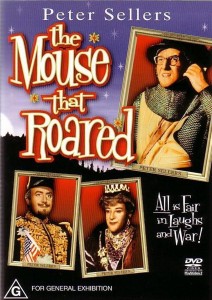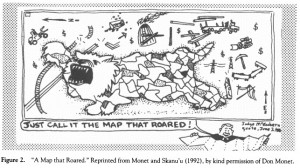3] In order to address this question you will need to refer to Sparke’s article, “A Map that Roared and an Original Atlas: Canada, Cartography, and the Narration of Nation.” You can easily find this article online. Read the section titled: “Contrapuntal Cartographies” (468 – 470). Write a blog that explains Sparke’s analysis of what Judge McEachern might have meant by this statement: “We’ll call this the map that roared.”
When Judge McEachem stated “We’ll call this the map that roared” the popular allusion noted was McEachern being demeaning about the cartography by the West’suwet’en and the Gitxsan. In his analysis “A Map that Roared and an Original Atlas: Canada, Cartography, and the Narration of Nation” within the section entitled “Contrapuntal Cartographies”, Sparke mentions that McEachern’s comment may be a reference to Peter Sellers 1959 film, “The Mouse That Roared”. This was an extremely clever association by Sparke, however, in order to completely understand the relationship between McEachems comment and Sellers film, one must know about the film. “The Mouse that Roared” is a film adaptation of Leonard Wibberley’s 1955 novel that satirizes Cold War geopolitics. The film takes place in a small fictional community in Europe after an attack in New York City. The Rotten Tomatoes description explains “In this film, the tiny country of Grand Fenwick faces economic ruin when their chief export of wine loses out to a California vintage. They declare war on the United States, hoping to receive money to rebuild the country after they lose. However, things don’t go according to plan”. The satire of this film is blatant and rude while it suspiciously correlates with Canadian politics, specifically the Delgamuukw trials.

To make this association clearer think of the Gitxkan and the Wet’suwet’en as the impoverished tiny European country in the film and think of the United States as the Canadian government. In the film, the European country declared war on the United States in order to receive a financial victory just as the Gitxkan and the Wet’suwet’en declared a court battle with the Canadian government in order to receive financial compensation, Aboriginal title and land declaration. After making this association I think it is quite clear what McEachern was saying when he stated “We’ll call this the map that roared”. Unfortunately, this comment of his is extremely insulting to the Gitxkan and the Wet’sewet’en as they are made to look like fools.
The cartographic maps are representations of the Gitxkan and the Wet’sewet’en people and they created these maps in “attempts to outline their sovereignty in a way Canadian court might understand” (Sparke 468). Unfortunately, rather than these maps helping the Gitxkan and the Wet’sewet’en people in court, McEachern dismissed their efforts to illustrate their presence on their land with “colonist claims about the extinguishment of aboriginal rights” (470).

I personally feel that McEachern was succumbing to colonialism during these trials and did not care to give the Gitxkan and the Wet’sewet’en the chance to prove their Aboriginal title and sovereignty. I also feel like the Supreme court agrees with me about that as they ended up overturning McEachern’s ruling so the trials cound continue and the Gitxkan and the Wet’sewet’en were given more time to prove sovereignty of their land, hurray!
Thanks for reading everyone 🙂
Works Cited
(1959), Rotten Tomatoes. “The Mouse That Roared”. Rottentomatoes.com. N.p., 2016. Web. 11 Mar. 2016.
BC Treaty Commission. “A Lay Pearson’s Guide To Delgamuukw”. N.p., 1999. Web. 11 Mar. 2016.
Sparke, Matthew. “A Map That Roared And An Original Atlas: Canada, Cartography, And The Narration Of Nation”. Annals of the Association of American Geographers 88.3 (1998): 463-495. Web. 11 Mar. 2016.